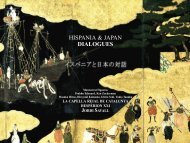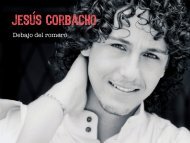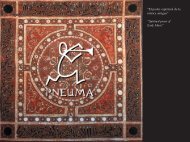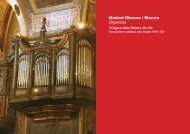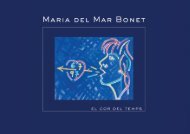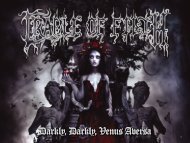AlOyS FlEiSchMANN
AlOyS FlEiSchMANN
AlOyS FlEiSchMANN
You also want an ePaper? Increase the reach of your titles
YUMPU automatically turns print PDFs into web optimized ePapers that Google loves.
xxx<br />
aloys<br />
fleischmann:<br />
orchestral works<br />
RTÉ National Symphony Orchestra<br />
Robert Houlihan Conductor, RTÉ Philharmonic Choir<br />
1
Aloys Fleischmann (1910-1992)<br />
1. The Four Masters (Overture 1944) 15.54<br />
2. Sinfonia Votiva (1977) 24.35<br />
2. Introduction 4.21<br />
3. Funeral March 13.36<br />
4. Bacchanal 6.36<br />
5. An Cóitín Dearg (Ballet Suite 1951) 19.12<br />
5. No. Prelude & No. 2 Figure Dance 3.23<br />
6. Men’s Dance 0.58<br />
7. Girl’s Dance 1.03<br />
8. Combined Dance 0.56<br />
9. No. 4 Romance 4.34<br />
10. No. 5 Fughetta and Passacaglia 3.40<br />
11. No. 7 Reel 2.26<br />
12. No. 8 Finale 2.12<br />
13. Clare’s Dragoons (1944)* 16.20<br />
RTÉ National Symphony Orchestra/ Robert Houlihan conductor<br />
*with the RTÉ Philharmonic Choir/ Mark Duley chorus master, Gavan Ring baritone,<br />
Pat Fitzpatrick warpipes<br />
2 1
aloys fleischmann: orchestral works<br />
Aloys Fleischmann (1910-1992) was one of the most prominent figures<br />
in Irish musical life of the last century, who made a cultural contribution<br />
of exceptional significance through his many-sided activities as a<br />
composer, performer, scholar and educator. His creative output is not<br />
extensive, comprising as it does just over fifty works, but many of these<br />
evince a refinement of craftsmanship and an imaginative distinction<br />
that undoubtedly place them amongst the finest achievements of their<br />
period. As a young man in the 1930s, Fleischmann wished to evolve a<br />
distinctively Irish style of composition, which, like the compositions of<br />
eminent contemporaries such as Bartók and Vaughan Williams, would<br />
draw on modern technical resources but be rooted in folk music. Several<br />
of the works on this recording arose out of this artistic engagement with<br />
Gaelic culture.<br />
In 1944, Fleischmann was commissioned to compose a new work for<br />
the tercentenary commemoration of the death of Micheál Ó Cléirigh,<br />
a Franciscan lay brother who was the chief of a group of seventeenthcentury<br />
annalists known collectively as The Four Masters. For a<br />
composer whose declared aim was ‘to delve into the hidden Ireland, and<br />
to create an idiom which would express in music some of the essence of<br />
2 3
this rich untapped literary tradition’, this was an ideal subject. The Four<br />
Masters evokes the romantic tales recounted in the Annals and suggests<br />
the pageantry at the court of an early Irish king.<br />
Cast in a broad sonata form, the overture commences with a slow<br />
introduction which the composer described as ‘archaic and medieval’.<br />
An energetic first subject in G major, the principal key of the work, gives<br />
way to an extended transition section, which is dominated by a distinctive<br />
syncopated rhythm. The lyrical second subject in C major is first heard<br />
on cellos and is expansively treated before the ensuing development<br />
section. After a recapitulation of the first subject, the transition material<br />
becomes the basis of a vigorous subsidiary developmental episode, in<br />
which, as Fleischmann suggests, ‘the din of battle may be heard’. The<br />
turbulence subsides and the first subject returns in the woodwind and<br />
strings before being restated in majestic augmentation in the brass.<br />
This climax leads to a triumphant return of the second subject which<br />
has been held in reserve until this moment. The work concludes with a<br />
marvellously imaginative coda: under a high string chord, a joyful peal<br />
of bells rings out, and after three sonorous chords in the orchestra, the<br />
pentatonic bell motif moves up through the strings until it eventually<br />
comes to rest on high octave Ds. Against these, a chord of E flat major is<br />
sounded three times by the harp, until finally the music dies away on a<br />
high sustained G major chord.<br />
Sinfonia Votiva was premiered at the 1978 Dublin Festival of<br />
Twentieth-Century Music by the Radio Telefís Éireann Symphony<br />
Orchestra with the composer conducting. This work grew out of an<br />
earlier score, Introduction and Funeral March, which was composed in<br />
1960; and although complete in itself, Fleischmann always intended it<br />
to form part of a larger composition. This plan was eventually realised<br />
in 1977, when he added a third movement. Dedicated to the memory<br />
of Edward Sheehy, a friend from Fleischmann’s student years, Sinfonia<br />
Votiva is one of the composer’s most personal utterances. According to<br />
his original programme note, the first two movements express ‘one’s<br />
reactions on first hearing of the loss of a close friend – the shock, the<br />
mounting frenzy of grief ’. The music here has an unrelieved and at times<br />
searing intensity, and despite the polytonal harmonic idiom, its deeplyfelt<br />
eloquence recalls the manner of late romanticism.<br />
The Introduction opens dramatically with an anguished idea in the<br />
strings, supported by horns and trombones. After building to a climax,<br />
the music collapses onto a low bass E flat over which we hear desolate,<br />
sighing fragments on two bassoons. The Funeral March, which ensues<br />
without a break, is cast in a broad ternary form; the steady crotchet tread<br />
of its bass lines is maintained continuously until the central trio. After a<br />
varied recapitulation of the march, a poignant coda recalls the material<br />
of the trio and brings the movement to a quiet close.<br />
4 5
The Bacchanal, as Fleischmann explained, ‘has a precedent in the<br />
funeral games of antiquity, in the merry-making which used to take<br />
place at Irish country wakes’. After an initial flourish of brilliant swirling<br />
figuration on woodwind and strings, the principal thematic material<br />
is stridently announced on trombones, cellos and double basses.<br />
The headlong pace relents for a recitative-like episode featuring solo<br />
bassoon and tuba which, ‘with apologies to Bartók’, is entitled Giuoco<br />
delle due inebriati [Game of the two drunks]. This is succeeded by a brief<br />
reflective Andantino. A resumption of the opening Allegro molto brings<br />
the symphony to a boisterous conclusion.<br />
Fleischmann composed his second ballet score An Cóitín Dearg [The<br />
Red Petticoat] in 1950-51 to a scenario by Micheál MacLiammóir, the<br />
Irish actor and playwright. Having been thwarted in their love, two young<br />
lovers, Colm and Nora, leave the west of Ireland separately for New York.<br />
Despite their more comfortable material circumstances there, they find<br />
that they are deeply unhappy, feeling themselves to be rootless. Both<br />
return home, but clothed in their American finery, they fail to recognise<br />
each other when they eventually meet. Colm changes back into his<br />
báinín, Nora into her red petticoat, and, as MacLiammóir put it: ‘when<br />
they return to the simplicity that is natural to them they recognise one<br />
another again and the love that is between them’. The outer acts of the<br />
ballet are set in the west of Ireland and depict a life which, if not by any<br />
means idyllic, is at any rate authentic: it is here, however frustrating their<br />
circumstances may be, that Colm and Nora finally realise they belong.<br />
Fleischmann described the music as being ‘to some extent<br />
astringently contemporary, to some extent neo-romantic, and of<br />
course impregnated with the idiom of Irish folk song’. The ballet<br />
played to capacity houses in Cork in May 1951. The following October,<br />
Fleischmann conducted the first performance with the Radio Éireann<br />
Symphony Orchestra of an eight-movement suite extracted from the<br />
score. (The suite has been slightly abbreviated for this recording, with<br />
movements 3: Theme and Variations and 6: Intermezzo omitted.)<br />
In 1945, the centenary of the death of the poet and patriot Thomas<br />
Davis was commemorated nationally and the Irish government<br />
commissioned a number of composers, including Fleischmann, to write<br />
new works for the celebrations. Davis’s political vision was based on an<br />
inclusive and non-sectarian nationalism. His literary output includes a<br />
large number of ballads in which he recounted important events in the<br />
history of his native country. These ballads, which were aimed at the<br />
widest possible audience, had an enormous and enduring influence.<br />
Fleischmann chose as the text of his new work one of the best known of<br />
6 7
them, Clare’s Dragoons, which portrays the courageous exploits of Irish<br />
émigrés in French armies during the eighteenth century.<br />
The forces used in Clare’s Dragoons (baritone solo, mixed-voice<br />
chorus and orchestra) include the war pipes, a folk instrument today<br />
akin to the Scottish bagpipes, which is used to brilliant effect. This idea<br />
was inspired by the virtuoso playing of a champion piper Joan Denise<br />
Moriarty, who participated in the first performance. The work’s thematic<br />
material is based on the popular melody to which Davis had composed<br />
the words of his ballad.<br />
The atmospheric opening of Clare’s Dragoons suggests the gradual<br />
approach of an army — evoked by a soft roll on the bass drum, to which<br />
divided double basses add a drone-like idea in parallel fifths. More<br />
definite melodic shapes soon begin to emerge, culminating in a vigorous<br />
march-like tune which gives way to a turbulent passage depicting the<br />
strife of combat. This prepares for the first choral entry, in which the<br />
first stanza of the ballad is sung to the traditional melody by the tenors<br />
and basses, followed by a full choral statement of the second stanza.<br />
The ensuing orchestral climax breaks off abruptly, and the war pipes<br />
are heard off-stage, as though from a distance, playing a tune in twelveeight<br />
time. As their sound fades, this idea is transferred to the orchestra,<br />
and features in the accompaniment to the setting of the third stanza for<br />
solo baritone.<br />
The impetuous choral polyphony of the fourth stanza is interrupted<br />
by the second entry of the baritone, who plaintively recalls Ireland’s<br />
wrongs. The mood soon turns to one of affirmation and, as the music<br />
builds to its final climax, the sound of the pipes is heard once more.<br />
In a marvellous coup de theatre, the piper marches from the rear of the<br />
auditorium and takes his place on stage with the other performers. The<br />
choir sings the final refrain and the march-like idea of the opening blazes<br />
out resplendently to bring the work to a triumphant conclusion.<br />
Séamas de Barra, February 2010<br />
RTÉ lyric fm gratefully acknowledges the support of the Fleischmann<br />
family in the production of this recording.<br />
8 9
Clare’s Dragoons<br />
by Thomas Davis<br />
When, on Ramillies’ bloody field,<br />
The baffled French were forced to yield,<br />
The victor Saxon backward reeled<br />
Before the charge of Clare’s dragoons.<br />
The flags we conquered in that fray<br />
Look lone in Ypres’ choir, they say.<br />
We’ll win them company today,<br />
Or bravely die like Clare’s dragoons<br />
Viva la, for Ireland’s wrong!<br />
Viva la, for Ireland’s right!<br />
Viva la, to battle throng,<br />
For a Spanish steed and sable bright!<br />
The brave old lord died near the fight,<br />
But, for each drop he lost that night,<br />
A Saxon cavalier shall bite<br />
The dust before Lord Clare’s dragoons.<br />
For never, when our spurs were set<br />
And never, when our sabres met,<br />
Could we the Saxon soldiers get<br />
To stand the shock of Clare’s dragoons.<br />
Viva la! the new brigade!<br />
Viva la! the old one too!<br />
Viva la! the rose shall fade,<br />
And the shamrock shine for ever new!<br />
Another Clare is here to lead,<br />
The worthy son of such a breed:<br />
The French expect some famous deed<br />
When Clare leads on his brave dragoons.<br />
Our colonel comes from Brian’s race,<br />
His wounds are in his chest and face,<br />
The bearna baoghail is still his place,<br />
The foremost of his brave dragoons.<br />
10 11
Viva la! the new brigade!<br />
Viva la! the old one too!<br />
Viva la! the rose shall fade,<br />
And the shamrock shine for ever new!<br />
There’s not a man in squadron here<br />
Was ever known to flinch or fear,<br />
Though first in charge and last in rere<br />
Have ever been Lord Clare’s dragoons.<br />
But see! we’ll soon have work to do<br />
To shame our boasts or prove them true,<br />
For hither come the English crew,<br />
To sweep away Lord Clare’s dragoons.<br />
Viva la, for Ireland’s wrong!<br />
Viva la, for Ireland’s right!<br />
Viva la, to battle throng,<br />
For a Spanish steed and sable bright!<br />
Oh! comrades, think how Ireland pines,<br />
Her exiled lords, her rifled shrines,<br />
Her dearest hope, the ordered lines,<br />
And bursting charge of Clare’s dragoons.<br />
Then fling your green flag to the sky<br />
Be Limerick your battle-cry,<br />
And charge, till blood floats fetlock high,<br />
Around the tract of Clare’s dragoons.<br />
Viva la! the new brigade!<br />
Viva la! the old one too!<br />
Viva la! the rose shall fade,<br />
And the shamrock shine for ever new!<br />
12 13
obert houlihan<br />
A native of Killarney, Robert Houlihan studied with George Hurst in<br />
England and Leon Barzin in Paris. Since winning awards at international<br />
competitions in France and Hungary, his career has taken him to conduct<br />
over 100 orchestras in Europe, USA, South America and South Africa. From<br />
1990 to 1993 he was Principal Conductor of the Tirgu Mures Philharmonic,<br />
Romania, and from 1992 to 1998 he was Principal Conductor and Artistic<br />
Director of the Savaria Symphony Orchestra, Hungary. He continues<br />
to work with the RTÉ National Symphony Orchestra and RTÉ Concert<br />
Orchestra as well as appearing as guest conductor with orchestras in<br />
Europe and South America.<br />
Robert Houlihan’s international festival appearances include the BBC<br />
Proms, the Almeida Fesival, London, the Bartók Festival, Hungary, and the<br />
Wexford Opera Festival. He has appeared at some of Europe’s prestigious<br />
concert halls - The Royal Albert Hall, London, The Concertgebouw,<br />
Amsterdam and the Musikverein, Vienna. He has recorded the works<br />
of major Irish composers A.J. Potter, Seóirse Bodley, Frederick May<br />
and Gerald Barry and is active as a teacher of conducting at the Canford<br />
Summer School of Music in England and around Europe.<br />
rté national symphony orchestra<br />
The RTÉ National Symphony Orchestra plays a central role in<br />
classical music in Ireland, through live performance, broadcast and<br />
touring. As an integral part of RTÉ, the orchestra reaches a great<br />
number of listeners through its weekly broadcasts on RTÉ lyric fm and<br />
through its association with the European Broadcasting Union (EBU). In<br />
addition to its annual subscription season, Horizons contemporary music<br />
series, summer concerts series, residencies and national tours, the<br />
orchestra continues to make a name for itself internationally through<br />
its recordings with Naxos, Marco Polo and on the RTÉ label. In 2004<br />
the RTÉ NSO won the Orchestra and Concerto: CD Première category of the<br />
Critics’ Awards in the 2004 Cannes Classical Awards for its recording of<br />
Joly Braga Santos’s Symphony No. 4 under conductor Alvaro Cassuto. In<br />
2005, Gerald Barry’s opera The Bitter Tears of Petra von Kant was released<br />
by RTÉ to considerable acclaim. This has been followed by CDs of work<br />
by Raymond Deane, Seóirse Bodley and Deirdre Gribbin, the latter two<br />
on the RTÉ lyric fm label.<br />
Full details of all upcoming RTÉ National Symphony Orchestra<br />
concerts are available on: www.rte.ie/nationalsymphonyorchestra<br />
14 15
té philharmonic choir<br />
Mark Duley chorus master<br />
The RTÉ Philharmonic Choir has been at the centre of choral music<br />
in Ireland since its foundation by Colin Mawby in 1985. It is the country’s<br />
premier symphonic choral ensemble. The choir works principally with<br />
the RTÉ orchestras in the performance of large-scale choral works and on<br />
occasion gives concerts in its own right. The choir broadcasts frequently<br />
on RTÉ lyric fm. Conductors with whom it has worked regularly include<br />
Gerhard Markson, Alexander Anissimov and the choir’s chorus master,<br />
Mark Duley.<br />
The choir performs between three and six concerts a year. Repertoire<br />
includes works such as Beethoven Symphony No. 9 in D minor, ‘Choral’;<br />
Mahler Symphony No. 2 in C minor ‘Resurrection’ and Symphony No.<br />
8 in E flat major ‘Symphony of a Thousand’; Brahms German Requiem;<br />
Schumann Das Paradies und die Peri; Elgar The Dream of Gerontius; Janáček<br />
Glagolitic Mass and Pärt Berliner Messe and Credo.<br />
Recorded: National Concert Hall, Dublin, 10-12 June 2009 and 12,13 October. Recording<br />
Producer: Gary Cole. Recording Engineers: Richard McCullough & Anton Timoney (Studio 1,<br />
RTÉ 15 January 2010). Cover and booklet images by kind permission of the Fleischmann Family<br />
16 Sleeve Notes: Séamas de Barra. Design: www.origin.ie. Executive Producer: Eoin Brady.<br />
17
Cork Symphony Orchestra Ballet Rehearsal, Old Opera House c.1950






